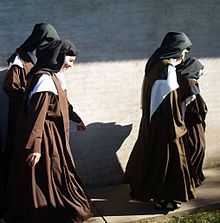Enclosed religious orders

Enclosed religious orders of the Christian churches have solemn vows with a strict separation from the affairs of the external world. The term cloistered is synonymous with enclosed. The enclosure is regulated by Catholic church law.[1][2] Rather strictly enforced in the past, it has taken nowadays more a symbolic value of separation from the world. The stated purpose for such enclosure is to prevent distraction from prayer and the religious life. Depending upon the reason and the length of time, the proper authority (usually the superior gets approval from the local bishop and/or the Holy See) can allow enclosed men or women religious to leave the enclosure (for study, for medical reasons, for work in the order or in a diocese, or rarely, to care for a relative, or even rarer, to visit one's family for a very special occasion- e.g., a funeral or wedding of a parent or sibling). More commonly, cloistered individuals are temporarily released from the obligation of enclosure to participate in a major religious event- a papal visit, a bishop's visit, a World Youth Day, or a major conference, for example. Canon law, the Holy See and the local ordinary, and the order's and individual cloister's superior and their statutes regulates this process. Some cloistered men are ordained, others are not. Some men and women who are cloistered may have knowledge of certain fields like education or health care, depending on their training during formation or the cloistered life, or prior to it. They can provide for the needs of their community, and, rarely, may be allowed to minister for a time outside the cloister. There are procedures in place for the cloistered to receive the needed utilities, communication needs, and medical needs while keeping leaving the cloister to a minimum.
Enclosed religious orders of men include the Benedictine monks, Bethlehem monks, Carthusian monks, Cistercian monks, Hieronymite monks, Trappist monks, and some Carmelite monks branches, and enclosed religious orders of women include the Augustinian nuns, Order of Bethlehem nuns, Carmelite nuns, Carthusian nuns, Conceptionist nuns, Minim nuns, Poor Clare nuns, Visitationist nuns, monasteries of Benedictine nuns, Dominican nuns and some Ursulines.
Contemplative orders
The English word monk most properly refers to men in monastic life, while the term friar more properly refers to mendicants active in the broader world (like Franciscans, Dominicans and Augustinians), though not all monasteries require strict enclosure. Benedictine monks, e.g., have often staffed parishes and been allowed to leave monastery confines.
Although the English word nun is often used to describe all Christian women who have joined religious institutes, strictly speaking, women are referred to as nuns only when they live in enclosure, otherwise they are religious sisters. The distinctions between the Christian terms monk, nun, friar, Brother, and Sister are sometimes easily blurred because some orders (such as the Dominicans or Augustinians) include nuns who are enclosed, who are usually grouped as the Second Order of that movement, and Religious Sisters who work in the broader world, who form a part of its Third Order.
Exclaustration
In the Roman rite of the Catholic Church, once a man or woman has made solemn, perpetual religious vows, the process of release from these monastic vows is not a simple one. It is not approved simply by the individual monastery, but requires the approval of the ecclesiastical authorities. Normally there is a transitional period, called exclaustration, in which the person looks to establish a new life and determine if this is what he or she is truly called to do. This usually lasts up to six years under the current Code of Canon Law. After this period, the appropriate authority — either the local bishop, or, more normally, the Holy See — normally determines that the wish to leave this life is valid and grants the former monk or nun release from their vows.
Anglican religious Orders have different procedures for the release from perpetual vows.
Monastic life
Contemplative orders[3] prioritise worship[4] and prayer over economic or outreach activity. They exist in the Roman Catholic, Anglican and Eastern Orthodox[5] traditions as well as in Buddhist[6] settings.
References
- ↑ VATICAN: Verbi Sponsa - Instruction on the Contemplative Life and on the Enclosure of Nuns
- ↑ The Code of Canon Law, Canon 667 ff. English translation copyright 1983 The Canon Law Society Trust
- ↑ Schadé, Johannes P. (2006). Encyclopedia of World Religions. Foreign Media Group. p. 220. ISBN 978-1-60136-000-7. Retrieved 2011-01-08.
Contemplative Order[: ] A religious community which engages exclusively, or almost exclusively, in activities directly ordered to contemplation.
- ↑ Gurdon, Edmund (1908). "Contemplative Life". The Catholic Encyclopedia, volume 4. New York: Robert Appleton Company. Retrieved 2011-01-08.
The great function assumed by contemplatives [...] is the worship of God.
- ↑ Bishop, George B. H. (2007). The Religion of Russia: A Study of the Orthodox Church in Russia from the Point of View of the Church in England. Gorgias Press LLC. p. 40. ISBN 978-1-59333-566-3. Retrieved 2011-01-08.
The rich variety of religious orders existing in Western Christendom finds no parallel in the Orthodox Church, where there is but one, the contemplative order of S. Basil.
- ↑ Cooray, L. J. Mark (1971). The reception in Ceylon of the English trust: an analysis of the case law and statutory principles relating to trusts and trustees in Ceylon in the light of the relevant foreign cases and authorities. Lake House Printers and Publishers. p. 168. Retrieved 2011-01-08.
[...] a trust for a contemplative order of Buddhist nuns was upheld.
See also
- Religious order
- Monasticism
- Cenobite
- Convent
External links
- New Advent Encyclopaedia III ff. on "Nuns, properly so called
- "Cloister" in the New Advent encyclopaedia
- Augustinian nuns
- The Cistercians in Australia
- The meaning of enclosure according to the Dominican nuns
- New Advent Encyclopaedia on "Religious Life
-
 "Contemplative Life". Catholic Encyclopedia. New York: Robert Appleton Company. 1913.
"Contemplative Life". Catholic Encyclopedia. New York: Robert Appleton Company. 1913.
| ||||||||||||||||||||||||||||||